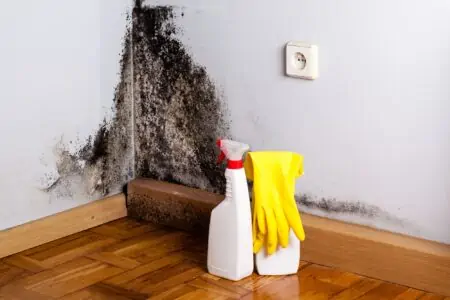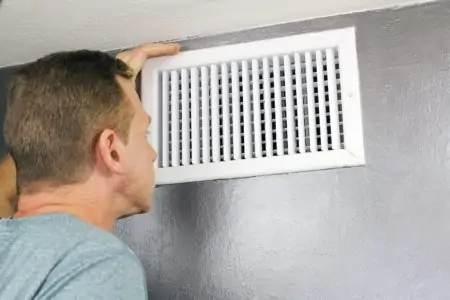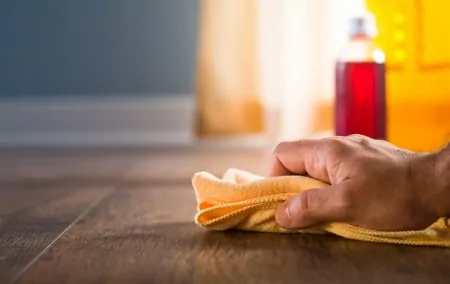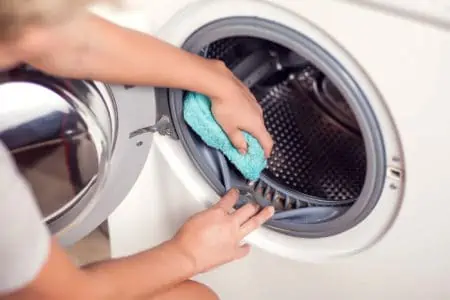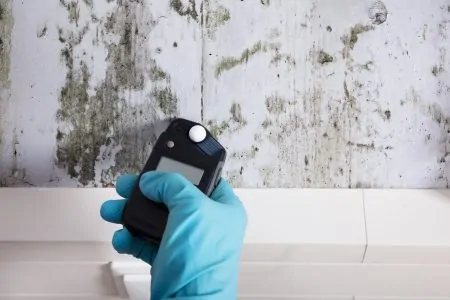Mold spores, unfortunately, are everywhere. They can be indoors and outdoors and thrive on any surface.
It’s important to have some basic knowledge about mold so that you can tackle it. The last thing you need is mold negatively affecting your life. Did you know that mold can cause allergic reactions and respiratory problems?
We’re here to share 26 important and interesting mold facts and statistics. We’ll cover interior mold, black mold, mold on food, and health effects from mold issues. By the end, you’ll know enough about mold to take the first steps to get rid of it.
Top 10 Mold Facts and Statistics
- Mold is a fungal growth that thrives in damp, warm environments.
- There could be up to 250,000 different species of mold, with 1,000 types in our home.
- A 2007 study found that mold exists in 47 percent of US homes.
- Mold will likely grow in the bathroom because of the water, humidity, and poor ventilation.
- Black mold is known as Stachybotrys chartarum, and it’s not always black; sometimes, it’s green.
- Black mold can make you sick, but there’s no evidence that it causes deadly diseases.
- If you’re allergic to black mold, it can make you very sick. Some symptoms include sneezing, an itchy throat, and a runny nose.
- All molds can cause health issues, whether in small amounts or large.
- Mold is used to make some foods, such as brie, blue cheese, and soy sauce.
- Twenty-six percent of food might contain mycotoxins which are dangerous to ingest.
Interesting Facts About Mold
Let’s start with some basic but very intriguing facts about mold. These bits of information might surprise you — but we think they’re vital to know.
- What is mold? Let’s start with the most basic question. Mold is a fungal growth that thrives and spreads on damp and warm surfaces or in humid environments. It survives by feeding on plants and decaying organic matter. But indoors, all it needs is moisture and a carbon source, such as building materials.
- There are many types: There could be up to 250,000 different species of mold and fungi out there in the world (1). More than 1,000 types of mold have been located inside US homes (a bit of a terrifying thought!).
- Bleach doesn’t always kill mold: You might think — bleach! It must kill mold! Well, unfortunately, bleach doesn’t always kill mold. In fact, it only works on nonporous surfaces such as ceramic or tile. If you want to kill mold on wood or drywall, bleach won’t do the trick.
- Penicillin is made from mold: This fact might freak you out, but it’s true. Penicillium is a mold that naturally produces the medicine penicillin (2). Scientists grow it in fermentation tanks before adding other ingredients. Don’t worry. It’s then separated from the mold before being used as an antibiotic medicine.
- Mold kills more trees than fires: Every year, mold is responsible for killing more wood and trees than fires and termites (3). It’s pretty lethal, this mold.
Interior Mold Facts
If you’re wondering about the role interior mold plays in your home, we have five mind-boggling facts. They might make you want to scrub your home from top to bottom, though.
- Common types of mold found in the home: The most common types of mold that thrive indoors include aspergillus, botrytis, chaetomium, cladosporium, Stachybotrys chartarum, Trichoderma, and more (4). Indoor mold usually thrives due to water damage, poor ventilation, high humidity levels, or just because of climate. These types of mold can cause bad odors, respiratory infections, allergic reactions, exacerbate asthma, or even contribute to depression.
- Forty-seven percent of homes have mold problems: A 2007 study found that 47 percent of US homes had a dampness or mold problem (5). Unfortunately, schools, buildings, workplaces, and other locations also have a similar issue. Unfortunately, this statistic is likely even higher in tropical climates. Therefore, mold exposure varies state by state.
- Tackling mold at home: When you notice mold in the home, do not ignore it. The quicker you act, the more effective your efforts will be. While you can tackle small areas of mold (less than 10 square feet) by yourself, you should hire a professional service provider for bigger areas. Make sure the contractor has experience with cleaning and killing mold.
- Mold in the bathroom: Mold will likely grow in the bathroom due to the water, humidity, and poor ventilation. The best tip for preventing mold in the bathroom is to increase ventilation. Keep a window open and a fan running. Clean your bathroom weekly to stay on top of mold and mildew growth.
- You might not see the mold: Unfortunately, mold can be detrimental because we usually can’t see it. Mold can grow inside drywall, and we won’t know about it until we start experiencing health issues. It also lives behind showers, inside our roof, or in crawl spaces. To put it bluntly, our homes are perfect for accommodating mold. It’s almost impossible to escape it.
- Mold-related infections are costly: Mold-related infections and damage cost 5.6 billion dollars per year in the US (6).
Black Mold Statistics
You’ve probably heard of the term ‘black mold.’ But what is it, what does it do, and how dangerous is it? Here are five black mold facts and stats.
- Black mold is Stachybotrys chartarum: When you hear experts talking about black mold, they’re referring to a type called Stachybotrys chartarum (7). It’s not always black; sometimes, it’s green. It can have a slime-like or shiny appearance, but other times, it can be dry. The main concern is that it can produce toxic chemicals that are dangerous to ingest.
- Black mold can make you sick: If you have allergies, asthma, or other hypersensitivities, black mold can worsen these symptoms. But, despite what you might have heard, there’s no evidence that black mold can cause deadly disease, headaches, memory loss, or fatigue. However, some people are allergic to mold — in that case, they should have this mold removed immediately.
- You might be allergic to black mold: Going off the last point, if you are allergic to black mold, it can make you very sick. Common symptoms include coughing and a runny nose, sneezing, dry skin, and an itchy nose, throat, and eyes.
- Black mold can lead to mold poisoning: One of the most significant ways to receive mold poisoning from black mold is by ingesting it (8). For example, if you eat moldy food, you could get quite sick. The symptoms to be aware of include body aches, mood changes, memory loss, nosebleeds, and headaches.
- How to treat black mold symptoms: If you’ve been exposed to black mold for a prolonged period and are suffering, you can take steps to treat the symptoms. Firstly, avoid the mold — have it removed or leave the premises, if possible. Always shower after coming home and reduce the humidity in your home. Invest in hard floors over carpets; take antihistamines; use eye drops or nasal sprays. When in doubt, contact your doctor.
Health Effects of Mold
Mold isn’t good for your health, but let’s dive deeper into that. Let’s look at how mold can affect your health, who’s at risk, and what to do about it.
- All molds can cause health issues: Whether you have black mold or a little mildew, they can all cause adverse health issues (9). So when you see mold, removing it should be a top priority. The other risk with mold is that it can compromise the stability of a building which can be a huge hazard to residents.
- Some people are more at risk than others: Immuno-compromised people, infants, elderly people, people with pre-existing health conditions, people with asthma, and people with allergies are more susceptible to mold. Their symptoms can range from mild cold symptoms to even memory loss.
- Mold can be in your heating and air conditioning system: Dampness and mold can lurk in heating and air-conditioning systems (10). This travels through air vents and infects the air in your home or office, causing many uncomfortable symptoms. This can include breathing issues, eye irritation, allergy attacks, and even skin lesions.
- Water damage and mold: Dampness is a big cause of mold, which is often caused by water damage. But even having water sources, like a fish tank, in your home can increase dampness and humidity. Research shows that dampness can cause respiratory illnesses. It goes further by promoting the infestation of cockroaches, dust mites, and horrible musty odors.
- Early mold exposure can cause asthma: If your young child is exposed to mold from an early age, it can increase their chances of developing asthma (11). If your child is already at risk of asthma, it’s vital to reduce excess exposure to mold.
Food and Mold Growth
We’ve all opened up a loaf of bread or jam jar to find mold. What is that mold? How did it get there, and what are the health effects of mold on food? Let’s dive into five key facts.
- Mold can grow on all foods: No food is safe from mold. But most commonly, mold is likely to grow on fruits, vegetables, bread, and cheese due to the porous nature and the high water content.
- You don’t need to throw out all moldy food: You can cut the mold off certain foods instead of discarding them. This includes firm fruit and vegetables — like apples — or hard cheese, hard salami, and country hams. If you’re cutting mold from the food, cut at least an inch around the mold.
- Mold is used to make some foods: Mold is used to make various kinds of blue cheese, Gorgonzola, brie, and camembert. It’s safe to eat these because they don’t produce harmful mycotoxins. Soy sauce is also made with the help of koji mold. The same goes for vinegar.
- Don’t eat mycotoxins: When food goes moldy, it can produce mycotoxins which are toxic. They can cause illnesses such as vomiting and diarrhea, but in extreme cases, they can also cause cancer and even death. Unfortunately, it’s pretty much impossible to avoid mycotoxins in your food altogether. The EFSA found that 26 percent of food might contain mycotoxins (12).
- Prevent mold on your food: It’s important to keep your food mold-free. Clean your fridge, bread box, and cupboards often. Keep your dishcloths and sponges clean. Take note of expiration dates; seal storage containers properly; freeze food if you can’t eat it right away. This will significantly decrease mold growth on your favorite foods.
FAQs
The Truth About Mold
These mold facts and stats have proved that mold is everywhere. It may even be present in every US home. While mold might not bother everyone, many people suffer from mold exposure.
Symptoms include sneezing, irritated eyes, fatigue, worsened allergies and asthma, dry skin, and more. Studies and evidence aren’t concrete if one type of mold is worse than the other.
But what is clear is that you should never ingest mold. Before eating, always cut off mold from firm foods like fruit and vegetables. Otherwise, discard the food.
Contact your doctor if you suffer from worse allergies, asthma, or extreme symptoms. And most importantly, when you notice mold, get it dealt with immediately, either by yourself or a professional.
